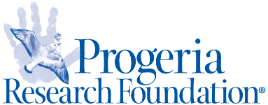Clinical Trials
From total obscurity in 1999 to first-ever clinical drug trials starting in 2007, PRF is leading the charge in the quest to discover treatments and the cure.
Trials history at-a-glance:
In just 17 years, since we founded PRF and there were no resources for these children, we have soared from total obscurity, to gene finding, to the first clinical trials in Progeria, to a first-ever treatment – all at a pace virtually unheard of in the scientific community. And while helping this handful of children, the connection of Progeria to common heart disease and aging has tremendous implications for us all.
To date, PRF has funded and co-coordinated four clinical trials:
| PRF is and always has been responsible for all trial expenses, including testing, travel, food, lodging, translators and staff. Each new trial is more expensive than the last, as more children enroll for a chance at longer, healthier lives. Please help us fund these vital trials – DONATE TODAY!
|
#1 involved a single drug lonafarnib, began in 2007, and proved successful;
#4 began in April 2016 and is ongoing. It is a 2-drug, phase 1 trial to determine the maximum tolerated dose (MTD) of the drug everolimus, which is being taken along with the treatment lonafarnib. Once the MTD is determined, PRF will fund and co-coordinate the phase 2 portion, which will test effectiveness of the 2-drug combination.
Click here to learn more about the current clinical trial.
Read all about the historic treatment discovery here, and below is the detailed history of these 4 trials.
May 7, 2007: The Start of the First-Ever Progeria Clinical Drug Trial Marks Historic Moment in Progeria Research History!
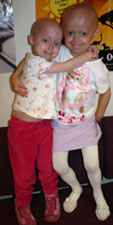 In 2006, researchers identified a potential drug treatment for children with Progeria, called FTIs. For the first time, we had in front of us a possible treatment for children with Progeria. Exciting times! The Progeria clinical drug trial began on May 7th, 2007 with two children – Meghan and Megan – arriving at Boston Children’s Hospital in Boston, MA for their first of seven visits over a 2-year period. At this first visit, they were given extensive tests and their first doses of the drug. An average of two families traveled to Boston each week thereafter, through December 2009, followed by a period of time in which the trial team analyzed the many thousands of data elements (each child underwent over 100 tests per visit!)and sought publication of the results.
In 2006, researchers identified a potential drug treatment for children with Progeria, called FTIs. For the first time, we had in front of us a possible treatment for children with Progeria. Exciting times! The Progeria clinical drug trial began on May 7th, 2007 with two children – Meghan and Megan – arriving at Boston Children’s Hospital in Boston, MA for their first of seven visits over a 2-year period. At this first visit, they were given extensive tests and their first doses of the drug. An average of two families traveled to Boston each week thereafter, through December 2009, followed by a period of time in which the trial team analyzed the many thousands of data elements (each child underwent over 100 tests per visit!)and sought publication of the results.
“I know of no other rare genetic disease that has gone from gene discovery to clinical trial in under four years – a phenomenal testament to the hard work of The Progeria Research Foundation.” Francis Collins, MD, PhD, Director of the National Human Genome Research Institute that mapped the human genome, workshop speaker and co-discoverer of the Progeria gene.
Twenty-eight (28) children from sixteen countries participated, ages 3 to 15 years. Children returned to Children’s Hospital Boston every four months, for testing and to receive new drug supply, and stayed in Boston for 4-8 days each visit. While at home, their doctors kept a close watch over the children and submitted periodic health reports to the Boston research team. For the duration of the trial, an average of 2 children per week traveled to Boston to participate.
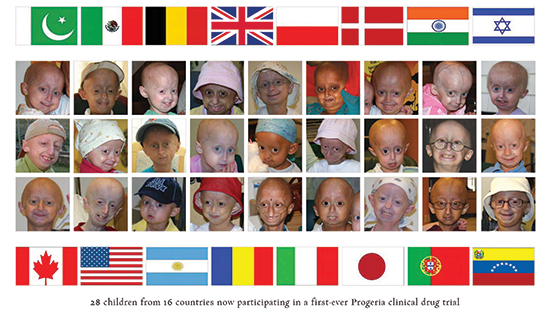
The Progeria Clinical Drug Trial: Who, Where, When, How and How Much…
The first three clinical trials were led by Mark Kieran MD, PhD, Director, Pediatric Medical Neuro-Oncology, Dana-Farber Cancer Institute and Children’s Hospital Boston; Assistant Professor, Departments of Pediatrics and Hematology/Oncology, Harvard Medical School. Dr. Kieran is a pediatric oncologist with extensive experience with the drug under study (farnesyltransferase, or FTI) in children. Co-Chairs were Monica Kleinman, MD, Director of Medical-Surgical Intensive Care Unit, Sr. Associate in Critical Care Medicine at BCH, Assistant Prof. at Harvard Medical School; and Leslie Gordon, MD, PhD, Medical Director of PRF, Lecturer at BCH and Harvard Medical School, Associate Prof. of Pediatrics at Hasbro Children’s Hospital and Brown University in Providence, RI. All three continue to lead the current trial, with Dr. Kleinman assuming the lead role of Principal Investigator. The clinical trials are a collaborative effort, involving physicians at Boston Children’s Hospital, Dana-Farber Cancer Institute, and Brigham and Women’s Hospital, all Harvard University institutions. In addition, physicians and scientists from The Warren Alpert Medical School at Brown University and NIH helped to make this first and the other trials a success.
How did we get to this point? In 2003, The Progeria Research Foundation’s collaborative research team discovered the Progeria gene. This discovery not only led to further understanding of Progeria, but scientists now know that studying Progeria can help us learn more about heart disease and the normal aging process that affects us all. Since the gene discovery, the support of researchers, clinicians, families of children with Progeria and people like YOU brought us to another crossroads in the search for a treatment. Researchers began an intense study of this enemy protein called progerin, and in 2006 they identified a potential drug treatment for children with Progeria, called farnesyltransferase inhibitors (FTIs), and conducted studies in the lab that supported a human trial with the drug. The FTI chosen is supplied by Merck and called lonafarnib. Click here for more details on the research.
Why did researchers think this drug would work in Progeria? The protein that we believe is responsible for Progeria is called progerin. In order to block normal cell function and cause Progeria, a molecule called a “farnesyl group” must be attached to the progerin protein. FTIs act by blocking (inhibiting) the attachment of the farnesyl group onto progerin. So if the FTI drug can block this farnesyl group attachment in children with Progeria, then progerin may be “paralyzed” and Progeria improved. Click here for more information on FTIs.

Normal cell, Progeria cell, Progeria cell after being treated with FTI
Progeria cells become normalized when FTIs are applied. Capell et al., PNAS, 2005
How did PRF fund the trial? Thanks to the support of thousands, we were able to raise all the funds necessary to cover the trial costs, including clinical testing, translators, staff, travel, food and lodging for the 28 families from 16 countries who came to Boston every four months for two years. Our heartfelt gratitude goes out to everyone who contributed their “time, talents and treasure” to make this incredible achievement possible, and of course to all the courageous families who participated.
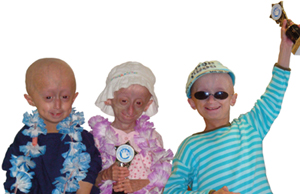
All of the children received trophies at their final, 2-year visit for the first-ever Progeria clinical drug trial. Here, Mateo, Milagros and Jesper are thrilled to get their awards.
The FTI lonafarnib is now a proven treatment for Progeria. In 2012 the study results were published, demonstrating that every child experienced improvement in one or more areas, including the vital cardiovascular system. And in May 2014, further study revealed lonafarnib (and possibly the other 2 drugs tested in the Triple Trial – see below) increases estimated lifespan by at least 1.6 years (time will tell if that number increases – it just hasn’t been long enough to determine.) Click here for details on the 2012 study, and here for details on the 2014 findings.
Always Moving Forward: The Progeria Triple Drug Trial Begins August 2009
Who Enrolled in the Triple Drug Trial?The Progeria Research Foundation and Boston Children’s Hospital once again partnered to conduct a new clinical trial for children with Progeria. This much larger trial initially included 45 children from 24 different countries!
Summary: Researchers identified two additional drugs that, when used in combination with the current FTI drug being tested (lonafarnib), may provide an even more effective treatment for children with Progeria than FTI’s alone. Pravastatin and zoledronate were added to the current treatment lonafarnib.
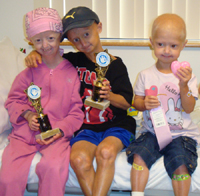
Hayley from England and Michiel from Belgium are all smiles as they pose with their trophies for completing the first-ever Progeria clinical drug trial in August, 2009. They also, along with Michiel’s sister Amber (right), completed their first visit for the triple drug trial that week.
Strategy: All three drugs target different points along the pathway leading to production of the disease-causing progerin. In exciting laboratory studies presented by Dr. Carlos Lopez-Otin of Spain at the 2007 Progeria Research Foundation Scientific Workshop, the two new drugs improved disease in Progeria cells and extended lifespan in mouse models of Progeria.
Goal: If the three drugs administered in this trial can effectively block this farnesyl group attachment, then progerin may be “paralyzed” and Progeria may be improved even more than it is with the lonafarnib alone. The hope is that the drugs will work as partners, to complement each other so that the progerin protein is affected more by combining the three drugs.
The Feasibility Trial: The team conducted a mini-trial for 5 children with Progeria. The short, one month “feasibility” trial asked whether the three-drug combination would be well-tolerated, prior to embarking on a larger international trial. Side effects were acceptable, and the team moved ahead to the larger efficacy trial.
The Efficacy Trial: 45 children enrolled in this trial, from 24 different countries, speaking 17 different languages. This includes children that participated in the FTI-only trial, the 5 participants in the feasibility trial, and other children that were either too young to participate in the first trial or children that we discovered during the first clinical trial (after enrollment had ended). Children enrolled in the FTI-only trial had the opportunity to enroll in the triple trial when they participated in their last visit for the current trial. This allowed those children to continue taking FTI without any missed doses.
The Treatment/Progeria Relationship
How did we get from gene discovery to drug therapy for children with Progeria? Finding the gene for Progeria was the key. This gene is called LMNA, and it normally encodes a protein called prelamin A (this protein is further processed and becomes lamin A). Children with Progeria have a mutation in LMNA which leads to the production of an abnormal form of prelamin A called “progerin.” Many years’ worth of basic research on prelamin A and lamin A gave us the ability to understand that the drugs administered in this trial may affect disease in Progeria. Over the past six years, research has focused on systematically testing these drugs on Progeria cells and Progeria mice.
The Clinical Trial Team
Since the first trial began in May 2007, a 28-member team has treated children with Progeria from around the globe. Members of the team have expertise not only in Progeria, but also in the drugs administered.
Trial Medications at a Glance
Pravastatin (marketed as Pravachol or Selektine) is a member of the drug class of statins. It is usually used for lowering cholesterol and preventing cardiovascular disease.
Zoledronic acid is a bisphosphonate, usually used as a bone drug for improving osteoporosis, and to prevent skeletal fractures in people suffering from some forms of cancer.
Lonafarnib is an FTI (Farnesyltransferase inhibitor), a drug that can reverse an abnormality in Progeria cells in the laboratory, and has improved disease in Progeria mice.
All 3 drugs block the production of the farnesyl molecule that is needed for progerin to create disease in Progeria.
* “Combined treatment with statins and aminobisphosphonates extends longevity in a mouse model of human premature aging”, by Ignacio Varela, Sandrine Pereira, Alejandro P. Ugalde, Claire L. Navarro, Marıa F. Suarez, Pierre Cau, Juan Cadinanos, Fernando G. Osorio, Nicolas Foray, Juan Cobo, Felix de Carlos, Nicolas Levy, Jose MP Freije and Carlos Lopez-Otın. Nature Medicine, 2008. 14(7): p. 767-72.
The new generation of children PRF is helping…
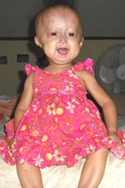 In March 2009, five children, ages 2-3, participated in the one-month feasibility study to determine if the side effects of the three drugs taken together were tolerable. The results were positive, paving the way for the full Triple Drug Trial to (initially) enroll up to 45 children with Progeria. Hats off to these amazing families! Here is what some of them had to say:
In March 2009, five children, ages 2-3, participated in the one-month feasibility study to determine if the side effects of the three drugs taken together were tolerable. The results were positive, paving the way for the full Triple Drug Trial to (initially) enroll up to 45 children with Progeria. Hats off to these amazing families! Here is what some of them had to say:
“EVERYONE has been so wonderful. To us you are ALL GOD SENT and we APPRECIATE all that you do for these little angels. Our family is so overwhelmed with excitement and all sorts of emotions with Adalia’s trip to Boston this weekend, I can’t even begin to type the words of how we are feeling”.
“This new medication for Zach gives us a renewed hope that his heart will be stronger, his smile will be brighter and his life will be longer. This new drug trial is an answer to our prayers. Thank you to everyone involved with PRF who made this happen…the doctors, the researchers and the staff. You are our heroes!”
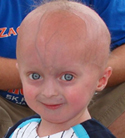
“On behalf of Cam and our family, thank you all at PRF so much for all you have done! We would have been lost in a world of confusion and grief without you. Instead, we live in a world of hope and purpose. Thank you again and again! With much love and respect,”
There were changes to the Triple Trial protocol.
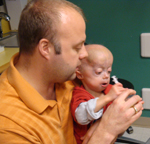
Cam and his dad learn how to mix the FTI drug with a sweetener.
The “Triple Trial” was extended beyond its original 2-3-year timeframe, and expanded to include up to 80 children, so that every child could have access to treatment that may give them longer and healthier lives. However, during this last trial phase, all children are taking lonafarnib alone while the trial team analyzes the many thousands of data elements (each child underwent over 100 tests per visit!) on the three-drug therapy phase of the trial. The triple therapy trial was pre-designed to include lonafarnib, pravastatin, and zoledronate. The hope is that adding two additional drugs to lonafarnib will boost the beneficial effects of the single drug therapy. While we know that lonafarnib is helping the children, it is still too early to tell if the other two are boosting the benefit. Usually, clinical trials run their course and the patients are taken off all the drugs until the data is analyzed to see if it helps; this could take years. PRF and the Boston Children’s Hospital team made the important decision to add additional time of lonafarnib treatment while the trial team explores other potential benefits and tracks any long-term side effects of lonafarnib, including lifespan. While the children continue to take the one known treatment, PRF and its research partners continue exploring additional treatment options – and have found one that they began testing in April 2016! Thus this last, lonafarnib only phase of the “Triple Trial” is overlapping with PRF’s fourth trial, and all known children living with Progeria today have the opportunity to participate in a clinical trial.
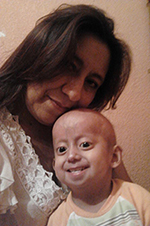
We are very happy with the visit…To know that we will have a better quality of life for my baby makes me feel amazing, as my wife says he is a “Warrior of Life “.
– Father of Angel, 3 years old, from Mexico, who came to Boston for his initial clinical clinical trial visit in August 2014
New Drug, New Hope for Children with Progeria: Phase 1, 2-Drug Trial Begins April 2016
PRF is thrilled to announce that we are now funding and co-coordinating a new clinical trial, which will assess a two-drug combination of lonafarnib plus everolimus. Everolimus is a form of the drug rapamycin, but everolimus can be more easily given to the children with Progeria because it requires fewer blood draws to measure drug levels. While lonafarnib may block progerin from developing, rapamycin appears to allow cells to more rapidly clear out the toxic progerin. Thus with rapamycin targeting a different pathway than lonafarnib, the combination may prove to be a “one-two punch” to Progeria – hopefully a better treatment than lonafarnib on its own.
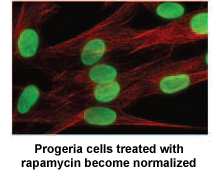
Rapamycin is an FDA-approved drug that has previously been shown to extend the lives of non-Progeria mouse models. A study* by researchers at the NIH in Bethesda, MD and Massachusetts General Hospital in Boston demonstrates that rapamycin decreases the amount of the disease-causing protein progerin by 50%, improves the abnormal nuclear shape, and extends the lifespan of Progeria cells in the laboratory.
| Rapamycin is known for its anti-aging properties in mice. These findings are part of a growing list of studies that help to validate the theory that finding the cure for Progeria may also benefit the entire aging population. |
* K. Cao, J. J. Graziotto, C. D. Blair, J. R. Mazzulli, M. R. Erdos, D. Krainc, F. S. Collins, “Rapamycin Reverses
Cellular Phenotypes and Enhances Mutant Protein Clearance in Hutchinson-Gilford Progeria Syndrome Cells.” Sci. Transl. Med. 3, 89ra58 (2011).
The Boston trial team will begin with Phase 1, where the study team will determine the safest maximum dose of everolimus for children with Progeria. The team begins by giving three children a very low dose of the medication, and carefully observes for side effects. If toxicity is minimal, another three children are enrolled at a higher dose of medicine. This pattern recurs until the safest maximum dose of everolimus is determined and the next study phase can begin. During Phase 2, the study will determine if the effects of the two-drug combination on disease are better than lonafarnib alone. Together, this Phase 1-2 treatment trial may enroll up to 80 children, and take an estimated 3.5-4 years to complete, at a cost of $2.5 million dollars.
The Progeria Research Foundation provided cells for this project from the PRF Cell & Tissue Bank and helped fund the research through our grants program – more proof that PRF’s research-related programs are essential to advancements toward the cure.
This new trial is a collaborative effort that will build upon the knowledge gained from the previous Progeria trials. The children will be seen by virtually the same team of physicians from Boston Children’s Hospital, Dana-Farber Cancer Institute and Brigham and Women’s Hospital, all of whom now have world-renowned expertise in Progeria as well as the drugs involved.
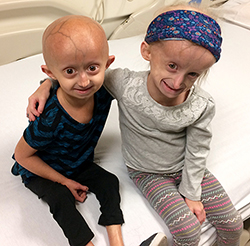 Zoey, 5 years old from New Jersey, and Carly, 6 years old from Ohio,
Zoey, 5 years old from New Jersey, and Carly, 6 years old from Ohio,
at Boston Children’s Hospital in April for enrollment in the 2-drug trial.
More children from around the world will join this new trial this year, thanks to your support.
As we begin this new chapter…
PRF is and always has been responsible for all trial expenses, including testing, travel, food, lodging, translators and staff. Each new trial is more expensive than the last, as more children enroll for a chance at longer, healthier lives. Please help us fund these vital trials – DONATE TODAY!
